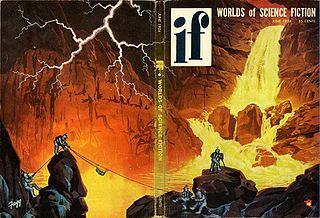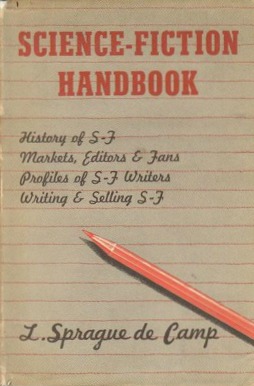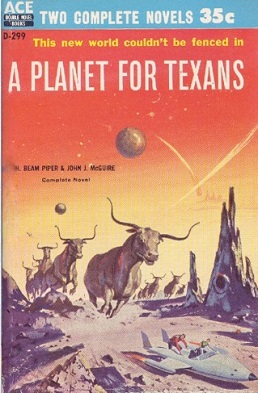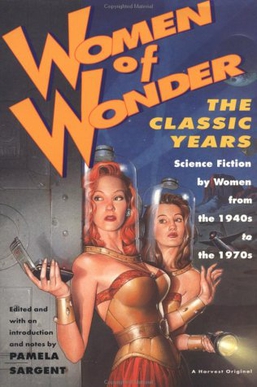
The Encyclopedia of Science Fiction (SFE) is an English language reference work on science fiction, first published in 1979. It has won the Hugo, Locus and British SF Awards. Two print editions appeared in 1979 and 1993. A third, continuously revised, edition was published online from 2011; a change of web host was announced as the launch of a fourth edition in 2021.
Locus: The Magazine of The Science Fiction & Fantasy Field, founded in 1968, is an American magazine published monthly in Oakland, California. It is the news organ and trade journal for the English-language science fiction and fantasy fields. It also publishes comprehensive listings of all new books published in the genres. The magazine also presents the annual Locus Awards. Locus Online was launched in April 1997, as a semi-autonomous web version of Locus Magazine.
Pamela Sargent is an American feminist, science fiction author, and editor. She has an MA in classical philosophy and has won a Nebula Award.

Fictional depictions of Mercury, the innermost planet of the Solar System, have gone through three distinct phases. Before much was known about the planet, it received scant attention. Later, when it was incorrectly believed that it was tidally locked with the Sun creating a permanent dayside and nightside, stories mainly focused on the conditions of the two sides and the narrow region of permanent twilight between. Since that misconception was dispelled in the 1960s, the planet has again received less attention from fiction writers, and stories have largely concentrated on the harsh environmental conditions that come from the planet's proximity to the Sun.
In science fiction, a time viewer, temporal viewer, or chronoscope is a device that allows another point in time to be observed. The concept has appeared since the late 19th century, constituting a significant yet relatively obscure subgenre of time travel fiction and appearing in various media including literature, cinema, and television. Stories usually explain the technology by referencing cutting-edge science, though sometimes invoking the supernatural instead. Most commonly only the past can be observed, though occasionally time viewers capable of showing the future appear; these devices are sometimes limited in terms of what information about the future can be obtained. Other variations on the concept include being able to listen to the past but not view it.

Planets outside of the Solar System have appeared in fiction since at least the 1850s, long before the first real ones were discovered in the 1990s. Most of these fictional planets do not differ significantly from the Earth, and serve only as settings for the narrative. The majority host native lifeforms, sometimes with humans integrated into the ecosystems. Fictional planets that are not Earth-like vary in many different ways. They may have significantly stronger or weaker gravity on their surfaces, or have a particularly hot or cold climate. Both desert planets and ocean planets appear, as do planets with unusual chemical conditions. Various peculiar planetary shapes have been depicted, including flattened, cubic, and toroidal. Some fictional planets exist in in multiple-star systems where the orbital mechanics can lead to exotic day–night or seasonal cycles, while others do not orbit any star at all. More fancifully, planets are occasionally portrayed as having sentience, though this is less common than stars receiving the same treatment or a planet's lifeforms having a collective consciousness.

Science-Fiction Handbook, subtitled The Writing of Imaginative Fiction, is a guide to writing and marketing science fiction and fantasy by L. Sprague de Camp, "one of the earliest books about modern sf." The original edition was published in hardcover by Hermitage House in 1953 as a volume in its Professional Writers Library series. A revised edition, by L. Sprague de Camp and Catherine Crook de Camp, titled Science Fiction Handbook, Revised, was published in hardcover by Owlswick Press in 1975 and as a trade paperback by McGraw-Hill in 1977. An E-book version of the revised edition was published by Gollancz's SF Gateway imprint on April 30, 2014.

Stars outside of the Solar System have been featured as settings in works of fiction since at least the 1600s, though this did not become commonplace until the pulp era of science fiction. Stars themselves are rarely a point of focus in fiction, their most common role being an indirect one as hosts of planetary systems. In stories where stars nevertheless do get specific attention, they play a variety of roles. Their appearance as points of light in the sky is significant in several stories where there are too many, too few, or an unexpected arrangement of them; in fantasy, they often serve as omens. Stars also appear as sources of power, be it the heat and light of their emanating radiation or superpowers. Certain stages of stellar evolution have received particular attention: supernovae, neutron stars, and black holes. Stars being depicted as sentient beings—whether portrayed as supernatural entities, personified in human form, or simply anthropomorphized as having intelligence—is a recurring theme. Real stars occasionally make appearances in science fiction, especially the nearest: the Alpha Centauri system, often portrayed as the destination of the first interstellar voyage. Tau Ceti, a relatively-nearby star regarded as a plausible candidate for harbouring habitable planets, is also popular.

Black holes, objects whose gravity is so strong that nothing—including light—can escape them, have been depicted in fiction since at least the pulp era of science fiction, before the term black hole was coined. A common portrayal at the time was of black holes as hazards to spacefarers, a motif that has also recurred in later works. The concept of black holes became popular in science and fiction alike in the 1960s. Authors quickly seized upon the relativistic effect of gravitational time dilation, whereby time passes more slowly closer to a black hole due to its immense gravitational field. Black holes also became a popular means of space travel in science fiction, especially when the notion of wormholes emerged as a relatively plausible way to achieve faster-than-light travel. In this concept, a black hole is connected to its theoretical opposite, a so-called white hole, and as such acts as a gateway to another point in space which might be very distant from the point of entry. More exotically, the point of emergence is occasionally portrayed as another point in time—thus enabling time travel—or even an entirely different universe.

"Exhalation" is a science fiction short story by American writer Ted Chiang, about the Second Law of Thermodynamics. It was first published in 2008 in the anthology Eclipse 2: New Science Fiction and Fantasy, edited by Jonathan Strahan. In 2019, the story was included in the collection of short stories Exhalation: Stories.

A Planet for Texans is a science-fiction novel written by Henry Beam Piper and John Joseph McGuire. It was first published in the March 1957 issue of Fantastic Universe as Lone Star Planet and first published in book form in Ace Double D-299 in 1958. The story originated in a suggestion by H. L. Mencken and presents a world on which the assassination of politicians is accepted practice. It eventually won a Prometheus Hall of Fame Award in 1999.

Women of Wonder: Science-fiction Stories by Women about Women is an anthology of twelve short stories and a poem edited by Pamela Sargent, published in 1975. The collection reprints work by female science fiction authors originally published from 1948 to 1973, arranged in chronological order.
"The Pi Man" is a science fiction short story by American writer Alfred Bester. It was first published in Fantasy and Science Fiction, in 1959. Bester subsequently revised it extensively for his 1976 collection Star Light, Star Bright, changing the characters' names, "develop(ing) minor scenes", modifying the typographical "word pictures", and deleting several "stale references to beatnik culture".
Raymon Huebert Aldridge is an American author of speculative fiction. He writes under the name Ray Aldridge.
John Hayden Howard (1925-2014) was an American educator, poet and science fiction author. He used the pen name Hayden Howard.
Sarah Antoinette LeFanu is a Scottish author and academic.
Jane Palmer is an author and illustrator of speculative fiction from the United Kingdom. In addition to novels, she writes short stories and children's picture books.

The New Women of Wonder: Recent Science Fiction Stories by Women About Women is an anthology of short stories, novelettes, novellas, and a poem edited by Pamela Sargent. The collection reprinted work by contemporary female science fiction authors, originally published from 1967 to 1977. It was published in 1978.

Women of Wonder, The Classic Years: Science Fiction by Women from the 1940s to the 1970s is an anthology of short stories, novelettes, and novellas edited by Pamela Sargent. It was published in 1995, along a companion volume, Women of Wonder, The Contemporary Years: Science Fiction by Women from the 1970s to the Present.

Women of Wonder, the Contemporary Years: Science Fiction by Women from the 1970s to the 1990s is an anthology of short stories, novelettes, and novellas edited by Pamela Sargent. It was published in 1995, along a companion volume, Women of Wonder,The Classic Years: Science Fiction by Women from the 1940s to the 1970s.












